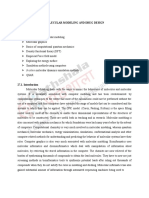0 ratings0% found this document useful (0 votes)
6 viewsMolecular Modeling
Molecular Modeling
Uploaded by
a40198617Molecular modeling refers to computational techniques used to study and simulate molecular behavior and interactions. It allows visualizing and predicting molecular structures and properties. Common techniques include molecular mechanics, quantum mechanics, and molecular dynamics simulations. Molecular modeling plays an important role in fields like drug discovery, materials science, biology, and biochemistry.
Copyright:
© All Rights Reserved
Available Formats
Download as PDF, TXT or read online from Scribd
Molecular Modeling
Molecular Modeling
Uploaded by
a401986170 ratings0% found this document useful (0 votes)
6 views4 pagesMolecular modeling refers to computational techniques used to study and simulate molecular behavior and interactions. It allows visualizing and predicting molecular structures and properties. Common techniques include molecular mechanics, quantum mechanics, and molecular dynamics simulations. Molecular modeling plays an important role in fields like drug discovery, materials science, biology, and biochemistry.
Original Title
molecular modeling
Copyright
© © All Rights Reserved
Available Formats
PDF, TXT or read online from Scribd
Share this document
Did you find this document useful?
Is this content inappropriate?
Molecular modeling refers to computational techniques used to study and simulate molecular behavior and interactions. It allows visualizing and predicting molecular structures and properties. Common techniques include molecular mechanics, quantum mechanics, and molecular dynamics simulations. Molecular modeling plays an important role in fields like drug discovery, materials science, biology, and biochemistry.
Copyright:
© All Rights Reserved
Available Formats
Download as PDF, TXT or read online from Scribd
Download as pdf or txt
0 ratings0% found this document useful (0 votes)
6 views4 pagesMolecular Modeling
Molecular Modeling
Uploaded by
a40198617Molecular modeling refers to computational techniques used to study and simulate molecular behavior and interactions. It allows visualizing and predicting molecular structures and properties. Common techniques include molecular mechanics, quantum mechanics, and molecular dynamics simulations. Molecular modeling plays an important role in fields like drug discovery, materials science, biology, and biochemistry.
Copyright:
© All Rights Reserved
Available Formats
Download as PDF, TXT or read online from Scribd
Download as pdf or txt
You are on page 1of 4
Introduction
Molecular modeling refers to computational techniques that are used to study
and simulate the behavior of molecules. It allows scientists to visualize,
simulate, and predict the 3-dimensional structures and interactions of
molecules. There are various levels of molecular modeling including molecular
mechanics, quantum mechanics, and molecular dynamics simulations.
Molecular modeling plays a very important role in many fields like drug
discovery, material science, biology and biochemistry.
Molecular Mechanics
Molecular mechanics is force field-based modeling approach that uses
approximated equations to simulate the interactions between atoms and
molecules. It is based on classical mechanics to model molecules as balls and
springs. Atoms are considered as points having mass and charges, and bonds
between them are considered as springs with associated force constants.
Parameters describing atoms and bonds are obtained from experimental data
and quantum mechanical calculations. Common molecular mechanics force
fields include AMBER, CHARMM and GROMOS. Molecular mechanics can
efficiently model large molecular systems with thousands of atoms over long
simulation periods reaching microseconds or milliseconds. It is used to study
conformational changes, folding of proteins and molecular docking process
involved in structure-based drug design. However, it cannot describe chemical
reactions and electronic properties.
Quantum Mechanics
Quantum mechanics modeling uses quantum mechanical equations like the
Schrödinger equation to describe molecular systems. It explicitly considers
electrons which allows calculating molecular properties from first principles.
Common quantum mechanics methods include density functional theory
(DFT), ab initio molecular orbital theory (MO) and semi-empirical quantum
chemistry. These techniques can provide accurate information about
molecular structures, vibrational frequencies, ionization potentials, electron
densities and energetics. However, they are computationally more intensive
and can only handle small molecular systems with less than 100 atoms over
short time periods of femtoseconds. Quantum mechanics methods play an
important role in understanding reaction mechanisms at the molecular level.
They provide insights into intermediate species, reaction barriers and
energetics which guide the design of catalysts and enzymes.
Molecular Dynamics Simulations
Molecular dynamics simulations combine molecular mechanics force fields
with numerical integration of Newton's equations of motion to simulate the
dynamic behavior of molecules over time. An initial set of positions and
velocities are specified, and the system is numerically integrated with small
time steps to determine its subsequent time evolution. Dynamic properties
like transport coefficients, infrared spectra, thermodynamic properties and
conformational changes in large biological molecules can be studied. MD
simulations are being extensively used to study biomolecular systems in detail.
They provide structural and dynamic insights into complex processes like
protein folding, protein-ligand/protein-protein interactions, enzyme
mechanisms and molecular transport through channels and pores over
nanosecond to millisecond periods. Recent advances in computer power and
simulation algorithms have enabled simulation of very large biomolecular
complexes involving millions of atoms for longer timescales.
Applications of Molecular Modeling
Drug Discovery
Molecular modeling plays a vital role in computer-aided drug design. Docking
studies identify potential binding poses of drug candidates in the active sites
of target proteins. Binding affinities are estimated via scoring functions.
Molecular dynamics refine docked complexes and provide dynamical insights
into interactions and resistance to dissociation. QSAR correlates chemical
structures to pharmacological properties for hit optimization. Homology
modeling builds target protein structures for structure-based approaches.
Material Science
Molecular simulations study fundamental properties governing material
behaviors. They provide microscopic details about structural properties,
defects, phase transitions and transport mechanisms in semiconductors,
metals, alloys and ceramics. New materials with desired properties are
engineered via computational screening prior to synthesis.
Biological Processes
Biomolecular modeling elucidates mechanisms of enzyme catalysis, signal
transduction, protein-protein interactions and assembly/disassembly
dynamics. It aids structural and functional annotation of genes/proteins of
unknown function. Toxicity and biocompatibility studies apply simulations to
biological systems.
Nanotechnology
Molecular modeling plays a key role in nanoscale material synthesis, assembly
and applications. It predicts properties of nanoclusters, nanopores, nanotubes
and their composites. Simulations guide self-assembly of nanodevices.
Limitations and Future Outlook
While molecular modeling provides crucial insights, results need to be
interpreted with care owing to approximations made. Multiscale modeling
integrates different levels of theory for a comprehensive description. Machine
learning facilitates fast screening of chemical/conformational spaces. Exascale
supercomputing will enable unprecedentedly long and large molecular
simulations. Advances will augment experimental methods to accelerate
scientific discovery and technologies across disciplines relying on atomic-level
understanding.
Conclusion
In summary, molecular modeling comprises powerful computational
techniques that permit visualization and simulation of molecular structures
and properties. It serves as a valuable complement to experimentation by
providing microscopic details and prediction capabilities. Widespread
applications exist in areas spanning drug discovery, biochemistry, materials
science and nanotechnology due to the technique's ability to study processes
at the molecular level. Continuing methodological and hardware
improvements ensure molecular modeling will remain an indispensable tool
assisting scientific and technological progress
You might also like
- Coptic Tattoo DesignsDocument352 pagesCoptic Tattoo DesignsAurel100% (7)
- The Fitness ChefDocument342 pagesThe Fitness ChefIulia Florina Sima100% (8)
- Hydraulic Questions For StudentsDocument8 pagesHydraulic Questions For StudentsJowi100% (1)
- Structural BiologyDocument5 pagesStructural Biologyemambujustine9No ratings yet
- BiophysicsDocument14 pagesBiophysicsKhawaja EshaNo ratings yet
- Advancements and Future Directions in Molecular Dynamics (MD) SimulationsDocument6 pagesAdvancements and Future Directions in Molecular Dynamics (MD) Simulationspublication1No ratings yet
- 1 s2.0 S0006349511022739 MainDocument1 page1 s2.0 S0006349511022739 Mainrully1234No ratings yet
- Assignment of CMBS by Qamar Shehzad.Document7 pagesAssignment of CMBS by Qamar Shehzad.huzaifasinan1No ratings yet
- Protonic NanoMachineDocument3 pagesProtonic NanoMachinemferraNo ratings yet
- Multi-Scale Modeling in Materials Science and EngineeringDocument12 pagesMulti-Scale Modeling in Materials Science and EngineeringonebyzerooutlookNo ratings yet
- Computer Simulation of Molecular Dynamics: Methodology, Applications, and Perspectives in ChemistryDocument32 pagesComputer Simulation of Molecular Dynamics: Methodology, Applications, and Perspectives in ChemistryAnatoli KrasilnikovNo ratings yet
- Sali Structure 2005Document3 pagesSali Structure 2005hahahaNo ratings yet
- Computational Approaches For Modeling ReguComputational Approaches For Modeling Regulatory Cellular Networkslatory Cellular NetworksDocument9 pagesComputational Approaches For Modeling ReguComputational Approaches For Modeling Regulatory Cellular Networkslatory Cellular NetworksJuan ManuelNo ratings yet
- Self-Organization in Biology: Technological AdvancesDocument2 pagesSelf-Organization in Biology: Technological AdvancesmamagansoNo ratings yet
- Applicationsofmolecularmodeling1 151106065509 Lva1 App6891Document35 pagesApplicationsofmolecularmodeling1 151106065509 Lva1 App6891rimipaul4687No ratings yet
- 1 s2.0 S1570963922000048 MainDocument13 pages1 s2.0 S1570963922000048 MainBen DresimNo ratings yet
- Molecular Modeling and Drug Design Learning ObjectivesDocument10 pagesMolecular Modeling and Drug Design Learning ObjectivesDionisio BrinosaNo ratings yet
- Mod 3 Part 2Document2 pagesMod 3 Part 2aiswaryaNo ratings yet
- Efficient Machine Learning Force Field For Large-Scale Molecular Simulations of Organic SystemsDocument23 pagesEfficient Machine Learning Force Field For Large-Scale Molecular Simulations of Organic SystemssokindracNo ratings yet
- Molecular Modelling & Drug DesignDocument52 pagesMolecular Modelling & Drug DesignArthe RajarajanNo ratings yet
- Atwell-Machine Learning Activation Energies of Chemical Reactions-article-review-NADocument31 pagesAtwell-Machine Learning Activation Energies of Chemical Reactions-article-review-NAalizahid000No ratings yet
- Lecture-3 - Role of Chemistry in Computer ScienceDocument11 pagesLecture-3 - Role of Chemistry in Computer Sciencemdeaqub hasanNo ratings yet
- Molecularcomputing ConradDocument10 pagesMolecularcomputing ConradJoe ShillabeerNo ratings yet
- 2008 Chapter BasicAtomisticModelingDocument64 pages2008 Chapter BasicAtomisticModelingHiran ChathurangaNo ratings yet
- VTech2008 KishorKurtDocument2 pagesVTech2008 KishorKurtHumair ShaheenNo ratings yet
- Statistical Measures To Quantify Similarity Between Molecular Dynamics Simulation TrajectoriesDocument17 pagesStatistical Measures To Quantify Similarity Between Molecular Dynamics Simulation TrajectoriesDiego GranadosNo ratings yet
- Molecular DynamicsDocument16 pagesMolecular DynamicsNimesh Singh100% (1)
- 75-Article Text-507-1-10-20240221Document8 pages75-Article Text-507-1-10-20240221mashhud.biochemistNo ratings yet
- Mustapha Hamdi, Antoine Ferreira and Constantinos Mavroidis - Molecular Nanosprings For Protein-Based NanoroboticsDocument9 pagesMustapha Hamdi, Antoine Ferreira and Constantinos Mavroidis - Molecular Nanosprings For Protein-Based NanoroboticsYopghm698No ratings yet
- Gromacs Molecular Modeling TutorialDocument11 pagesGromacs Molecular Modeling Tutorialca_teixeiraNo ratings yet
- Computational Cell Biology Second ThemeDocument5 pagesComputational Cell Biology Second ThemeGifty RenacidoNo ratings yet
- Molecular Dynamics Simulations: Erik LindahlDocument24 pagesMolecular Dynamics Simulations: Erik LindahlKübra KahveciNo ratings yet
- Chromatophore Manuscript Final 03 24 19Document25 pagesChromatophore Manuscript Final 03 24 19SigmundNo ratings yet
- Biomolecules: Quantum Mechanical Modeling: A Tool For The Understanding of Enzyme ReactionsDocument41 pagesBiomolecules: Quantum Mechanical Modeling: A Tool For The Understanding of Enzyme ReactionsCarlos Alberto Dutra Fraga FilhoNo ratings yet
- Cellular Mechanotransduction Putting All The Pieces Together Again - Ingber2006Document18 pagesCellular Mechanotransduction Putting All The Pieces Together Again - Ingber2006hjakamjNo ratings yet
- ChemBioChem - 2023 - Baiardi - Quantum Computing For Molecular BiologyDocument24 pagesChemBioChem - 2023 - Baiardi - Quantum Computing For Molecular BiologyOnur KayaNo ratings yet
- Lecture 2.1 Role of Chemistry in Computer ScienceDocument11 pagesLecture 2.1 Role of Chemistry in Computer SciencethehostsmmNo ratings yet
- Network SimulationDocument9 pagesNetwork SimulationAnaGarciaNo ratings yet
- Lecture 1.3 & 2.1 Role of Chemistry in Computer ScienceDocument9 pagesLecture 1.3 & 2.1 Role of Chemistry in Computer SciencethehostsmmNo ratings yet
- Journal Pre-Proof: Acta BiomaterialiaDocument28 pagesJournal Pre-Proof: Acta BiomaterialiaAndresNo ratings yet
- SimulationDocument2 pagesSimulationSatyendra Pal SinghNo ratings yet
- Molecular Modeling: A Powerful Tool For Drug Design and Molecular DockingDocument10 pagesMolecular Modeling: A Powerful Tool For Drug Design and Molecular DockingGabrielė BalčiūnaitėNo ratings yet
- Statistical Inference of The Time-Varying Structure of Gene-Regulation NetworksDocument16 pagesStatistical Inference of The Time-Varying Structure of Gene-Regulation NetworksRochmat HimawanNo ratings yet
- Quantum Mechanics in Molecular ModelingDocument34 pagesQuantum Mechanics in Molecular Modelingjayavhad4552No ratings yet
- Quantum Mechanical Methods in Computational ChemistryDocument5 pagesQuantum Mechanical Methods in Computational Chemistrypublication1No ratings yet
- ML Techniques in Molecular Modeling Seminar All ExaggeratedDocument7 pagesML Techniques in Molecular Modeling Seminar All Exaggeratedpatrarajesh8895No ratings yet
- Computational Enzymology: Methods in Molecular Biology (Clifton, N.J.) January 2013Document25 pagesComputational Enzymology: Methods in Molecular Biology (Clifton, N.J.) January 2013detki007No ratings yet
- Neural Network Kinetics: Diffusion Multiplicity and B2 Ordering in Compositionally Complex AlloysDocument33 pagesNeural Network Kinetics: Diffusion Multiplicity and B2 Ordering in Compositionally Complex AlloysLoginNo ratings yet
- A. A. Zhuravlev Et Al., 2020. Multiscale Discrete Element ModelingDocument11 pagesA. A. Zhuravlev Et Al., 2020. Multiscale Discrete Element ModelingMichael PisfilNo ratings yet
- Molecular Modelling: Principles and Applications: PrefaceDocument12 pagesMolecular Modelling: Principles and Applications: PrefaceHarsha Vardhan JNo ratings yet
- Descriptive Information About Molecular DynamicsDocument2 pagesDescriptive Information About Molecular DynamicsaniketbhagatNo ratings yet
- Modulation of Calmodulin Plasticity by The Effect of Macromolecular CrowdingDocument11 pagesModulation of Calmodulin Plasticity by The Effect of Macromolecular Crowdingsmileman_csNo ratings yet
- Noncovalent Interactions in Inorganic Supramolecular Chemistry PDFDocument16 pagesNoncovalent Interactions in Inorganic Supramolecular Chemistry PDFJason BourneNo ratings yet
- Application of Computational Chemistry in Material ModelingDocument5 pagesApplication of Computational Chemistry in Material ModelingBeeki MANo ratings yet
- Molecular Dynamics Simulations: Dr.M.Chandra SekharDocument24 pagesMolecular Dynamics Simulations: Dr.M.Chandra SekharchandraloveNo ratings yet
- An Introduction To Molecular ModelingDocument10 pagesAn Introduction To Molecular ModelingVidya MNo ratings yet
- MainDocument9 pagesMainpaxjr2No ratings yet
- Molecular DynamicsDocument389 pagesMolecular Dynamicsnjlg2866No ratings yet
- Fed Batch Reactor Hufr67ezexzDocument6 pagesFed Batch Reactor Hufr67ezexzClaudia Vivi AnantaNo ratings yet
- Clustering Molecular Dynamics Trajectories - I. Characterizing The Performance of Different Clustering AlgorithmsDocument44 pagesClustering Molecular Dynamics Trajectories - I. Characterizing The Performance of Different Clustering AlgorithmsyunniemNo ratings yet
- Bio MEMSDocument16 pagesBio MEMStronghuynh12No ratings yet
- Integration Study GuideDocument11 pagesIntegration Study GuideIrfan KhanNo ratings yet
- Magnolia CleopatraDocument2 pagesMagnolia CleopatraVladescu DianaNo ratings yet
- 04 Performance Task 1Document2 pages04 Performance Task 1Angel HagsNo ratings yet
- Porters Diamond ModelDocument16 pagesPorters Diamond ModelArnav ChaturvediNo ratings yet
- Gorgias Encomium of Helen Violent Rhetoric or Radical Feminism PDFDocument21 pagesGorgias Encomium of Helen Violent Rhetoric or Radical Feminism PDFFelipe NicastroNo ratings yet
- 5 - Trichomonas VaginalisDocument16 pages5 - Trichomonas Vaginalisعبد الرحمن حامدNo ratings yet
- 05A CompressionDocument102 pages05A CompressionNishat AhmadNo ratings yet
- Ebook PDF Clinical Veterinary Microbiology Elsevieron Vitalsource 2nd Edition PDFDocument41 pagesEbook PDF Clinical Veterinary Microbiology Elsevieron Vitalsource 2nd Edition PDFcharles.macdonald430100% (50)
- Previous Years Questions (2017-) Segment-Wise: Ordinary Differential EquationsDocument14 pagesPrevious Years Questions (2017-) Segment-Wise: Ordinary Differential EquationsakashNo ratings yet
- The HyperbolaDocument13 pagesThe HyperbolaJorge VargasNo ratings yet
- Power System Profile of The State Of: Andhra PradeshDocument49 pagesPower System Profile of The State Of: Andhra PradeshAnand MuraliNo ratings yet
- Full Video Production Handbook Fourth Edition Gerald Millerson C.Eng Miee Msmpte Ebook All ChaptersDocument70 pagesFull Video Production Handbook Fourth Edition Gerald Millerson C.Eng Miee Msmpte Ebook All Chapterstchatochazz100% (12)
- Blackrock: BGF Sustainable Energy A2Document2 pagesBlackrock: BGF Sustainable Energy A2vikingo de suescaNo ratings yet
- Math - Grade IXDocument11 pagesMath - Grade IXAisha MuneerNo ratings yet
- A.1: Do I Know You?: WritingDocument12 pagesA.1: Do I Know You?: Writingflery2009No ratings yet
- Balcanica: Institute For Balkan StudiesDocument21 pagesBalcanica: Institute For Balkan StudiesGajevic SlavenNo ratings yet
- Irrigation AssDocument7 pagesIrrigation AssGemechuNo ratings yet
- Tle - Home EconomicsDocument54 pagesTle - Home EconomicsAnna VergelNo ratings yet
- 2 Open Letter To Protect Nasca Ridge - March 2024Document2 pages2 Open Letter To Protect Nasca Ridge - March 2024carlos.estacioNo ratings yet
- Electrical Surveying Part II: Induced Polarization Method: WS0708 Dr. Laurent MarescotDocument29 pagesElectrical Surveying Part II: Induced Polarization Method: WS0708 Dr. Laurent MarescotfanisaNo ratings yet
- 11th Standard Environment Education English 21Document98 pages11th Standard Environment Education English 21Good BadNo ratings yet
- VX 8R ManualDocument172 pagesVX 8R Manualvulture212No ratings yet
- 0811-2 Concentrated Solar Energy - HelioDynamicsDocument20 pages0811-2 Concentrated Solar Energy - HelioDynamicsjames_stone4458No ratings yet
- Vertical Car Parking SystemDocument6 pagesVertical Car Parking SystemVaibhav BhardwajNo ratings yet
- Double Jacketed GasketsDocument1 pageDouble Jacketed GasketsShayan Hasan KhanNo ratings yet
- Marketing and Management Models A Guide To Understanding and Using Business Models First Edition Yvonne Helen Strong Download PDFDocument53 pagesMarketing and Management Models A Guide To Understanding and Using Business Models First Edition Yvonne Helen Strong Download PDFniffashoraj100% (2)
- ZTH2506 2Document1 pageZTH2506 2WarishNo ratings yet

























































































